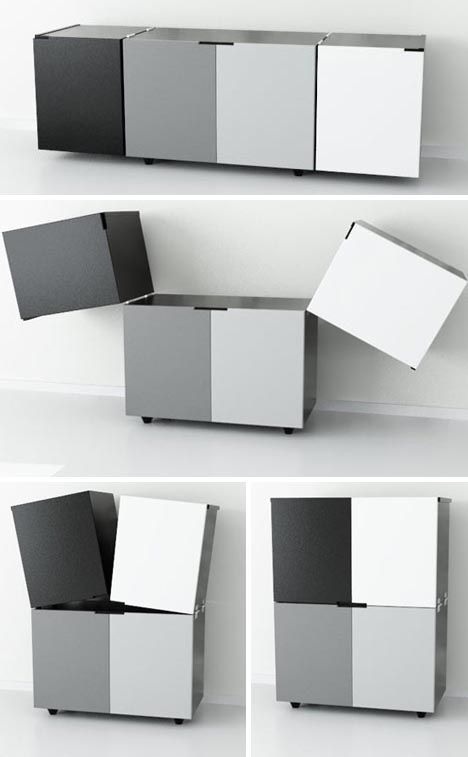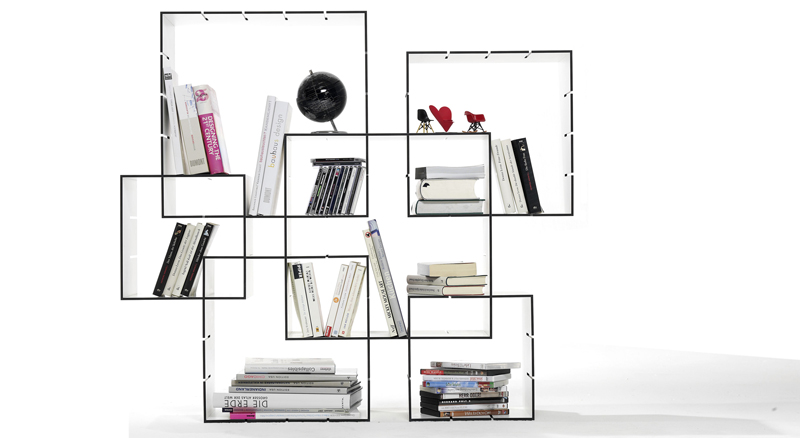This piece was definitely designed with space limitations in mind. Cubox from Elemento Diseno is a horisontal string of boxes that can form several different configurations. The end cabinets can be flipped up, and the whole piece can be transformed into two vertical stacks of two, cutting the required floor area in half. The color scheme is a bit boring (black, white and two gray shades in between), but it makes Cubox even more universal.
Source: Dornob
Collecting things is one of the basic human conditions, and flaunting them is one of the known joys. In a small space, however, doing so could be tricky. Display furniture often costs a lot in square footage and provides little function. Unless it can perform other roles. This collector’s table from the New York-based architect John Berg is a great example. A walnut frame supports two sheets of glass; the collector’s treasures float in between. The top sheet of glass slides from side to side to allow for object placement. The shape of the piece has a slight retro flair, which makes this clever table a display-worthy item by itself.
You know what they say – all things are temporary, unless they were designed by Charles Eames. This chair was not. However, there is something unmistakably Eamesian about the shape and the use of the materials. The Shrimp Armchair, designed by Jehs+Laub for Cor, is a new twist on the universally loved classic. The piece appeals to all human senses with its elegant curves, firm support, and refined workmanship. As Design Milk pointed out, the leather looks as though it sinks directly into the plywood, which creates the effect of lightness. Truly mesmerizing piece of design. And who knows, maybe in half a century the Shrimp Armchair will be the one to emulate.
Here is an example of taking a good idea and making it even better. Initially the Window table, created by Eero Koivisto for Offecct, had an inserted colored glass feature that served as a stylish way to indicate the storage area. Now Koivisto went further and replaced the glass with an insertion for flowers and plants. The result is refreshing and chic. The timing is right too. Spring is coming, so it might be a good idea to give those planters another optimistic try…
No matter what kind of opinions you hold on the subject, your cat will always believe that climbing on top of bookcases is awesome. And majestically eyeing the premises from the top shelf is even awesomer. You can enter a painful (and most likely futile) process of imposing restrictions on the cat, or you can embrase the inevitable and give him/her this brilliant thing. Created by belgian designer Corentin Dombrecht, the Cat Library bookcase is made in a shape of a staircase with a built-in sitting basket at its top. The piece is modular, which allows to fit it in any space. According to Designboom, the shelf is intentionally unpainted and is not oiled, so that the surface is not too slippery for cat paws. So, this may be furniture to you, to your cat it is just another toy. But isn’t this true for everything else in your home?
Here is an idea – furniture inspired by puzzles. And not just any puzzles – burr puzzles, assembled without a single nail or fastener. The result – a collection of beautiful pieces, made of natural, ecological materials, with no high-tech and no harmful glues. The project belongs to the Bulgarian studio Praktrik and created by the designer Petar Zaharinov, who sees big utilitarian and environmental potential in this puzzle idea. All items are sold in pieces that can be assembled and disassembled if not exactly with ease, but definitely with a lot of fun.
The Stockholm Furniture Fair 2011 is in full swing, and the first news are coming in. Yesterday the world beheld the winner of the Forms+1 Award for the best product at this year’s exhibition. The award went to Thomas Bernstrand for his stackable storage system, called Ivy. This unusual piece, produced by the Swedish company Swedese, consists of five stackable components that can be arranged in three ways: straight-up, leaning to one side, or alternating. The last two choices allow to play with the object, creating fun and dynamic shelving. But even in a traditional, straight-up version it looks rather interesting. And because the Ivy system is stackable, you can customize it, divite it in two, or take it apart completely with ease.
This project has won the Interior Innovation Award during Imm Cologne 2011, which is not the least bit surprising. German designer Florian Gross has created a universally likable piece, called Konnex, that has all attributes we want to see in a bookcase. It is light, modular, stackable, easy to put together, fully customizable in any room, big or small. And because the bookcase can be taken apart and stored in a form of nested modules, it is easy to ship as well. The combinations and uses of the Konnex bookcase are endless, it can even be paired with other furniture pieces, put under your desk, for example. Sold in sets of 3, the slot-in units can be stacked, added to, arranged and rearranged to the extent of your budget and imagination.


There is no reason whatsoever for bringing a boring bookcase into your home. Especially when pieces like this one exist. Designed by Kittichai Reawsanguanwong, the Chinese Checkered Bookshelf was made to draw attention to itself. According to Yanko Design, the bookshelf joints are fitted with magnets to hold the chess pieces. Although not actually playable, the pieces can be rearranged to add visual interest and variety. They can also hold notes and small items. The bookcase was displayed during the ‘Imprints: Designing for Memories’ exhibition at the National Museum of Singapore.





A spacious and functional workspace in the morning, a social hot-spot in the afternoon, and a dining table at night – these are the roles this piece of furniture can play. A truly multifunctional table, called Doppelleben, is the recent creation of the Ahhaproject design studio. The idea is ingenious in its simplicity. The tabletop consists of two layers. If you need to use the lower layer, you can slide two lightweight panels down the sides. And when the work is done (or is safe to be interrupted), the panels come up creating a surface for dining and entertaining. This working/dining combo is merely a suggestion, of course. You can use the lower layer tabletop as a bookshelf, a utensil storage, a display for your collectables, or in any way you see fit.


























